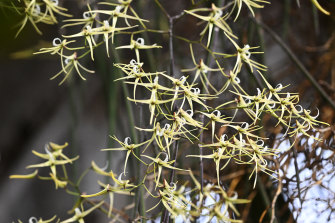A rat’s tail orchid doesn’t sound like something you’d seek out. The plant gets its common name from the long thin cylindrical leaves, which, if you’re a glass-half-empty type of person, do resemble rat’s tails.
In late winter, though, the rat’s tail is a total showstopper. It casts off its dowdy persona and covers itself with fragrant, starry little white flowers, giving it its alternative name, the bridal veil orchid.
Bridal Veil Orchid, or a rat’s tail orchid at Royal Botanical Garden in Sydney.Credit:Louise Kennerley
You can see it now along creeks, lakes and swamps anywhere from Calliope north of Brisbane or south to Bega. Or, more easily, at the Royal Botanic Garden Sydney.
The plant’s botanical name is Dockrillia teretifolium, commemorating the self-trained, amateur orchid botanist Alick Dockrill. Dockrill was born in Enmore, in Sydney’s Inner West, in 1915 and fell in love with Australian orchids as a boy. Despite his lack of formal training, his devotion to native orchids and his meticulous observations led him to become an authority. He literally wrote the book on Australian orchids, publishing ‘Australian Indigenous Orchids’ in 1969, and revising it in 1992. Dockrill died in 2011.
The Dockrillia in the Botanic Garden was collected in the wild in 1959 by another local amateur orchidist. The anonymous man from Concord donated the plant to the Botanic Garden in 1988.
The slow-growing orchid, which has now lived 62 years in captivity, is a metre and half long, hanging high up in an old Port Jackson fig east of the Palm House. The fig is reaching the end of its life and is starting to lose branches, opening up the canopy and allowing more light onto the orchid, improving the flowering, while also opening up the view of the orchid from below.
“The leaves are cylindrical and not that easy to see, especially up so high, but once it flowers it’s just vibrant,” says Randy Sing, nursery supervisor at RBG. It’s unusual for the orchid to be growing in a fig, as in the wild it favours Casuarina glauca as a home. “They like the same conditions,” explains Sing. “Both like to grow around waterways and it likes the high light levels and humidity off the water.”
The specimen at RBG does its dramatic thing with no help at all from the gardeners. “It would benefit from some fertiliser, there’s no question,” says Sing, “but it’s too high up in the tree.” The bridal veil orchids in the RBG glasshouse, which are grown on cork, are fertilised weekly in the spring and summer and fortnightly through autumn and winter. And that’s the way to get the best results from bridal veil orchids grown at home.
But if you don’t have the right position at home, go visit the old beauty in the Botanic Garden over the next few weeks. It’s just one stunner from the more than 800 different orchid species native and unique to Australia, as Alick Dockrill would no doubt have told us.
Make the most of your health, relationships, fitness and nutrition with our Live Well newsletter. Get it in your inbox every Monday.
Most Viewed in Lifestyle
Source: Read Full Article



